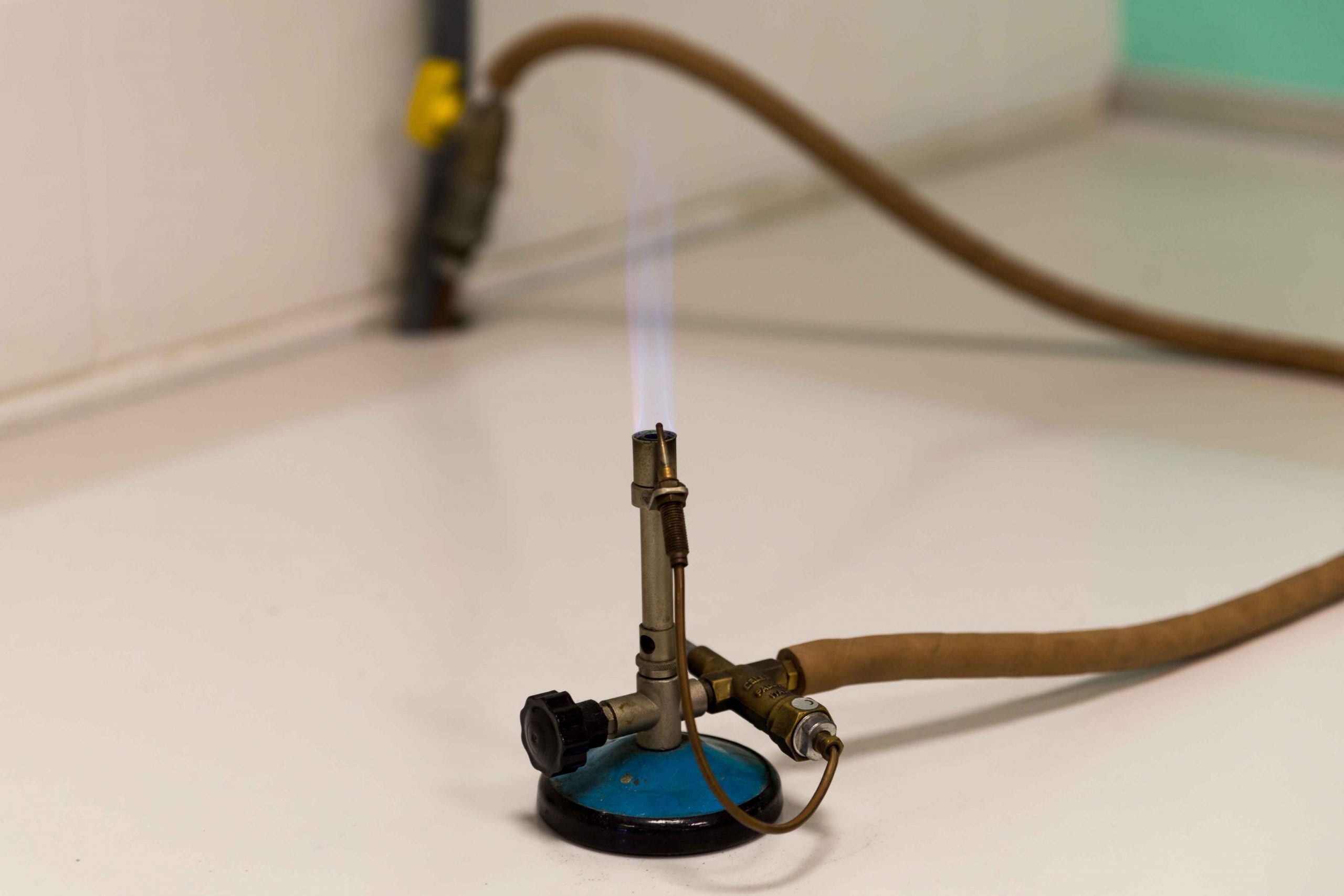The Bunsen burner, invented by German chemist Robert Bunsen in 1855, is a commonly used laboratory equipment that has stood the test of time. It was developed by Bunsen and Peter Desaga, a mechanic at the University of Heidelberg, to utilise the newly fitted coal-gas lines in their lab.
Today, the Bunsen burner remains a crucial tool in various laboratory experiments such as chemical reactions, distillation, and evaporation. Additionally, its high temperature can be used to sterilise equipment such as forceps, scalpels, and other tools, making it a versatile and useful tool for a range of laboratory applications.
More laboratory common uses for this lab essential include:
- Heating substances: Bunsen burners can provide a consistent, adjustable flame that can be used to heat substances in beakers, test tubes, and other containers.
- Flame tests: Bunsen burners can be used to conduct flame tests to identify the presence of certain elements in a sample. When a substance is heated in a flame, it emits a characteristic colour that can be used to identify it.
- Glass blowing: Bunsen burners are often used in glass blowing to soften the glass and shape it into various forms.
- Drying samples: Bunsen burners can be used to dry samples by heating them to a temperature that causes the moisture to evaporate.
In this Evolve essential guide, we look at:
- What Is a Bunsen Burner
- What Are the Three Types of Flame on A Bunsen Burner
- How To Safely Use a Bunsen Burner
- Required Practicals That Use a Bunsen Burner

What Is a Bunsen Burner?
Bunsen burners are commonly found on laboratory benches and are used in various science experiments due to their ability to produce a hot, non-luminous flame that is free of soot. This is achieved by mixing gas and oxygen in a controlled environment, which allows for precise regulation of the burner’s size and heat.
Rubber tubing is used to connect the Bunsen burner to a gas valve, making it suitable for use in any laboratory with gas lines. The flame is situated at the mouth of the tube at the top of the equipment and can be utilized to create a convection current.
The standard natural rubber tubing has been used for many years, but longer lasting and more resilient tubes made from neoprene or a polymer blend like Enduraflex are also available. Other essential components of the Bunsen burner include the gas inlet, air control vent, barrel, and base. The air hole and control vent are critical in regulating the amount of air in the instrument and controlling the size and type of the flame.
What Are the Types of Flame On A Bunsen Burner?
Bunsen burners are versatile tools that can generate different types of flames, each suitable for specific scenarios. The three main types of flames produced by Bunsen burners are:
Yellow Flame: Known as the safety flame due to its high visibility and low temperature of approximately 300°C.
Blue flame: This flame can reach temperatures of up to 500 degrees and is produced when the air hole is partially open, although it may be difficult to see in a bright room.
Roaring Blue Flame: This is the hottest Bunsen burner flame and can reach temperatures of up to 700°C, but requires the air hole to be fully open.
How To Safely Use a Bunsen Burner
Using a Bunsen burner in a lab requires careful attention and precautions due to the open flame and high temperature, which can pose a fire hazard and risk of accidents if not handled properly. It is crucial to keep the following safety tips in mind when working with a Bunsen burner:
- Check the equipment: Before you start using a Bunsen burner, make sure it is in good working condition. Always inspect the rubber tubing for holes, cracks, or any defect which could cause a leak. Replace any hoses or tubes which are damaged. Check the gas supply and make sure the tubing is securely connected.
- Clear the area: Ensure the area around the Bunsen burner and the area you are working in is clear of any flammable materials, including notebooks, paper, or chemicals. They should never be placed underneath shelves, light fixtures, or other equipment. Keep at least 12 inches of space clear above a Bunsen burner.
- Set up the burner: Place the Bunsen burner on a heat-resistant surface and connect it to the gas supply. Adjust the air intake until the flame is blue and stable.
- Light the burner: Never light a Bunsen burner flame with a match, instead use a lighter with an extended nozzle. Hold it close to the top of the burner, just above the air intake. Have your lighter ready to go before turning on the gas tap. Turn on the gas supply and the flame should ignite. If it doesn’t, turn off the gas supply and wait a few seconds before trying again.
- Adjust the flame: Adjust the air intake to control the size and temperature of the flame.
- Self-check: Long hair must be tied back, and jewellery or loose clothing should be avoided. Wear protective gear such as safety goggles / spectacles and a lab coat.
- Use a safety flame: When you are not using the Bunsen burner, use a safety flame. This is a small, low flame that will prevent gas from leaking out and causing a fire.
- Never leave unattended: Do not leave a Bunsen burner unattended, even on the safety flame.
- Handle the burner with care: Remember the Bunsen burner is metal and can get hot. Do not handle it until it cools.
- Turn off the burner: When you are finished using the Bunsen burner, turn off the gas supply and let it cool down completely before storing it away. Do not handle it while it is still hot.
Practicals That Use a Bunsen Burner
Some of the most common experiments that use a Bunsen burner:
- Heating substances: Bunsen burners are used to heat substances in beakers, test tubes, and other containers. This is a fundamental experiment that students often conduct to learn about the effects of heat on substances.
- Flame tests: In this experiment, you use a Bunsen burner to heat different metal salts and observe the characteristic colors that are emitted by the flames. This experiment helps students learn about atomic structure and the properties of elements.
- Investigating combustion: You can use a Bunsen burner to investigate the conditions required for combustion. They can experiment with different types of fuels, oxygen levels, and temperature to observe the effects on combustion.
- Identifying gases: In this experiment, you use a Bunsen burner to burn different gases and observe the characteristics of the flames. This can help students identify the different gases by their flame color and other properties.
- Investigating thermal decomposition: You can use a Bunsen burner to heat different compounds and observe their decomposition products. This experiment helps students learn about chemical reactions and the effect of heat on compounds.
Overall, Bunsen burners are a fundamental tool in many required practicals in science classes in schools and universities.
For more information, feel free to get in touch with our friendly team today. You can also contact us on +356 2248 9900 or email info@evolveltd.eu
Scientific supplies for labs, utilities and field testing
Evolve’s commitment to you
Evolve helps medics, researchers, technicians and scientists increase efficiency and productivity every day.
We are a leading supplier of laboratory equipment and analytical instruments for scientific, R&D, educational and medical laboratories in Malta, Europe and beyond. We back all our lab equipment products with unbiased technical assistance to help you solve your application needs.
At Evolve, we always…
- Put our customers first – We dedicate our energy and efforts to sourcing great quality products and exceeding customer service expectations.
- Act with integrity – We build relationships based on honesty, trust and transparency with our customers, colleagues and the communities we serve.
- Strive for simplicity – We believe that simplicity lowers costs for our customers, increases efficiencies and makes life easier for everyone.
- Enjoy what we do – We work hard, try our best, share and celebrate success and love what we do. It makes our lives better and results in better customer service.


